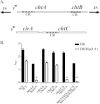Utilization of host iron sources by Corynebacterium diphtheriae: multiple hemoglobin-binding proteins are essential for the use of iron from the hemoglobin-haptoglobin complex
- PMID: 25404705
- PMCID: PMC4285985
- DOI: 10.1128/JB.02413-14
Utilization of host iron sources by Corynebacterium diphtheriae: multiple hemoglobin-binding proteins are essential for the use of iron from the hemoglobin-haptoglobin complex
Abstract
The use of hemin iron by Corynebacterium diphtheriae requires the DtxR- and iron-regulated ABC hemin transporter HmuTUV and the secreted Hb-binding protein HtaA. We recently described two surface anchored proteins, ChtA and ChtC, which also bind hemin and Hb. ChtA and ChtC share structural similarities to HtaA; however, a function for ChtA and ChtC was not determined. In this study, we identified additional host iron sources that are utilized by C. diphtheriae. We show that several C. diphtheriae strains use the hemoglobin-haptoglobin (Hb-Hp) complex as an iron source. We report that an htaA deletion mutant of C. diphtheriae strain 1737 is unable to use the Hb-Hp complex as an iron source, and we further demonstrate that a chtA-chtC double mutant is also unable to use Hb-Hp iron. Single-deletion mutants of chtA or chtC use Hb-Hp iron in a manner similar to that of the wild type. These findings suggest that both HtaA and either ChtA or ChtC are essential for the use of Hb-Hp iron. Enzyme-linked immunosorbent assay (ELISA) studies show that HtaA binds the Hb-Hp complex, and the substitution of a conserved tyrosine (Y361) for alanine in HtaA results in significantly reduced binding. C. diphtheriae was also able to use human serum albumin (HSA) and myoglobin (Mb) but not hemopexin as iron sources. These studies identify a biological function for the ChtA and ChtC proteins and demonstrate that the use of the Hb-Hp complex as an iron source by C. diphtheriae requires multiple iron-regulated surface components.
Copyright © 2015, American Society for Microbiology. All Rights Reserved.
Figures








Similar articles
-
Corynebacterium diphtheriae Iron-Regulated Surface Protein HbpA Is Involved in the Utilization of the Hemoglobin-Haptoglobin Complex as an Iron Source.J Bacteriol. 2018 Mar 12;200(7):e00676-17. doi: 10.1128/JB.00676-17. Print 2018 Apr 1. J Bacteriol. 2018. PMID: 29311283 Free PMC article.
-
Analysis of novel iron-regulated, surface-anchored hemin-binding proteins in Corynebacterium diphtheriae.J Bacteriol. 2013 Jun;195(12):2852-63. doi: 10.1128/JB.00244-13. Epub 2013 Apr 12. J Bacteriol. 2013. PMID: 23585541 Free PMC article.
-
Novel hemin binding domains in the Corynebacterium diphtheriae HtaA protein interact with hemoglobin and are critical for heme iron utilization by HtaA.J Bacteriol. 2011 Oct;193(19):5374-85. doi: 10.1128/JB.05508-11. Epub 2011 Jul 29. J Bacteriol. 2011. PMID: 21803991 Free PMC article.
-
Trapping of human hemoglobin by haptoglobin: molecular mechanisms and clinical applications.Antioxid Redox Signal. 2013 Jun 10;18(17):2364-74. doi: 10.1089/ars.2012.4878. Epub 2012 Oct 18. Antioxid Redox Signal. 2013. PMID: 22900934 Review.
-
Biology and molecular epidemiology of diphtheria toxin and the tox gene.J Infect Dis. 2000 Feb;181 Suppl 1:S156-67. doi: 10.1086/315554. J Infect Dis. 2000. PMID: 10657208 Review.
Cited by
-
Analysis of the Manganese and MntR Regulon in Corynebacterium diphtheriae.J Bacteriol. 2021 Sep 23;203(20):e0027421. doi: 10.1128/JB.00274-21. Epub 2021 Aug 9. J Bacteriol. 2021. PMID: 34370555 Free PMC article.
-
Pirates of the haemoglobin.Microb Cell. 2022 Feb 18;9(4):84-102. doi: 10.15698/mic2022.04.775. eCollection 2022 Apr 4. Microb Cell. 2022. PMID: 35434122 Free PMC article. Review.
-
Transcriptome sequencing of the human pathogen Corynebacterium diphtheriae NCTC 13129 provides detailed insights into its transcriptional landscape and into DtxR-mediated transcriptional regulation.BMC Genomics. 2018 Jan 25;19(1):82. doi: 10.1186/s12864-018-4481-8. BMC Genomics. 2018. PMID: 29370758 Free PMC article.
-
Heme Binding by Corynebacterium diphtheriae HmuT: Function and Heme Environment.Biochemistry. 2015 Nov 3;54(43):6598-609. doi: 10.1021/acs.biochem.5b00666. Epub 2015 Oct 26. Biochemistry. 2015. PMID: 26478504 Free PMC article.
-
Heme sequestration by hemophilin from Haemophilus haemolyticus reduces respiratory tract colonization and infection with non-typeable Haemophilus influenzae.mSphere. 2024 Mar 26;9(3):e0000624. doi: 10.1128/msphere.00006-24. Epub 2024 Feb 21. mSphere. 2024. PMID: 38380941 Free PMC article.
References
Publication types
MeSH terms
Substances
LinkOut - more resources
Full Text Sources
Other Literature Sources
Medical
Research Materials
Miscellaneous

